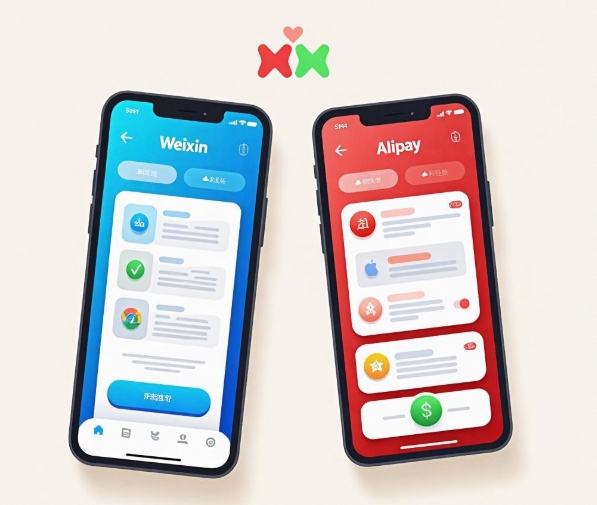Cross-platform compatibility issues in mini-program development.
- latest articles
- 1.DApp Development & Customization: Merging Diverse Market Needs with User Experience 2.Analysis of the Core Technical System in DApp Project Development 3.How to achieve cross-chain interoperability in Web3 projects? 4.How does the tokenization of points reconstruct the e-commerce ecosystem? 5.How to Set and Track Data Metrics for a Points Mall? 6.What is DApp Development? Core Concepts and Technical Analysis 7.Inventory of commonly used Web3 development tools and usage tips 8.Development of a Distribution System Integrated with Social E-commerce 9.Six Key Steps for Businesses to Build a Points Mall System 10.What is DApp Development? A Comprehensive Guide from Concept to Implementation
- Popular Articles
- 1.Future Trends and Technology Predictions for APP Development in 2025 2.Analysis of the DeFi Ecosystem: How Developers Can Participate in Decentralized Finance Innovation 3.From Zero to One: How PI Mall Revolutionizes the Traditional E-commerce Model 4.DAPP Development | Best Practices for Professional Customization and Rapid Launch 5.Recommended by the Web3 developer community: the most noteworthy forums and resources 6.From Cloud Computing to Computing Power Leasing: Building a Flexible and Scalable Computing Resource Platform 7.How to Develop a Successful Douyin Mini Program: Technical Architecture and Best Practices 8.Shared Bike System APP: The Convenient Choice in the Era of Smart Travel 9.How to Create a Successful Dating App: From Needs Analysis to User Experience Design 10.From Design to Development: The Complete Process of Bringing an APP Idea to Life
With the rapid development of mobile internet, mini-programs, as a lightweight application form, have been widely adopted across multiple platforms. Whether it's WeChat Mini Programs, Alipay Mini Programs, or Baidu Mini Programs, they all present challenges that developers must address. Although these platforms have undergone significant optimization for user experience, compatibility issues between different platforms have gradually emerged due to differences in their development environments and system architectures. This article will explore cross-platform compatibility issues in mini-program development, analyze their causes, and propose some solutions.
I. Background of Cross-Platform Compatibility Issues
As a new form of development, mini-programs differ from traditional mobile applications in that their greatest advantage lies in being accessible without downloading or installing; users can open and use them directly through major platforms. The lightweight nature of mini-programs allows developers to quickly roll out new features, saving development time and costs. However, it is precisely this openness that exposes mini-programs to a series of cross-platform compatibility issues.
First, the frameworks and development specifications for mini-programs vary across platforms. WeChat Mini Programs, Alipay Mini Programs, Baidu Mini Programs, ByteDance Mini Programs, and others each have their own unique development tools, APIs, and lifecycle management. This results in the same mini-program potentially behaving differently on different platforms, or even encountering incompatibility issues.
Second, the user base, hardware environment, and operating system versions of each platform also differ, which can affect the compatibility and stability of mini-programs.
II. Common Types of Cross-Platform Compatibility Issues
1. API Inconsistencies
The APIs provided by different platforms for mini-programs vary, and developers may need to use certain platform-specific API functionalities during development. The implementation and invocation methods of these APIs can differ across platforms. For example, WeChat Mini Programs provide the "wx.request" interface for making network requests, while Alipay Mini Programs use the "my.request" interface, requiring developers to differentiate and handle platform-specific aspects during development.
Another typical example is the API for payment functionality. In WeChat Mini Programs and Alipay Mini Programs, the implementation of payment interfaces, parameter passing, and payment callbacks differ significantly. Developers need to write corresponding code logic for each platform; otherwise, the payment function may not work properly across platforms.
2. Styling and UI Compatibility Issues
Different platforms also handle UI rendering and styling differently. For instance, the interface of WeChat Mini Programs may be influenced by WeChat's own UI style, while the interfaces of Alipay and Baidu Mini Programs may align more closely with their respective platform's brand design. This means the same code may produce different visual effects on different platforms, potentially impacting the user experience.
Additionally, the CSS styles supported by different platforms may vary. For example, certain CSS3 features may not render correctly on some platforms, or the level of CSS support may differ. Developers need to make adjustments based on the actual situation to ensure the interface displays properly across all platforms.
3. Differences in Events and Interaction Methods
The level of support for user interactions varies across platforms, leading to differences in how events behave. For example, WeChat Mini Programs and Alipay Mini Programs may respond differently to touch events in certain scenarios. WeChat Mini Programs might offer richer gesture operation support, while Alipay Mini Programs may be more limited in this regard.
In complex interaction scenarios, such as multi-touch, drag-and-drop, and scrolling operations, cross-platform compatibility issues become particularly pronounced. Developers need to pay special attention to event handling on different platforms to ensure smooth and consistent interactions.
4. System Permissions and Hardware Differences
Different platforms may require mini-programs to obtain varying system permissions and hardware support. For example, the requirements and handling of location information, camera permissions, and storage permissions may differ between WeChat Mini Programs and Alipay Mini Programs. Additionally, the level of hardware device support varies across platforms, which may prevent certain devices from running mini-programs smoothly.
For instance, some platforms may not support older operating system versions or specific hardware devices, rendering certain mini-program functionalities unusable. This undoubtedly increases the difficulty of debugging and optimization for developers.
5. Network Environment and Performance Differences
Mini-programs on different platforms may face varying network environments and performance bottlenecks. WeChat Mini Programs typically run within the WeChat environment, meaning their network requests may be affected by WeChat's own traffic restrictions. Alipay Mini Programs and Baidu Mini Programs, on the other hand, may exhibit different performance characteristics in specific environments.
For example, some platforms may prioritize background task processing and memory management, while others focus more on front-end rendering and response speed. These differences directly impact the loading speed, operational stability, and user experience of mini-programs.
III. Methods to Address Cross-Platform Compatibility Issues
1. Using Cross-Platform Development Frameworks
To simplify cross-platform development, many developers opt for cross-platform development frameworks such as Taro, UniApp, and MPX. These frameworks help reduce platform-specific code branches by providing unified API interfaces and component libraries. With these frameworks, developers can write code once and use the framework's compilation tools to generate versions of the mini-program suitable for different platforms. For instance, UniApp supports the development of WeChat Mini Programs, Alipay Mini Programs, Baidu Mini Programs, and more through its unified development environment, significantly reducing the difficulty of cross-platform development.
The advantage of using cross-platform frameworks is that developers can focus on core business logic without worrying about the detailed differences between platforms. Additionally, these frameworks often predefine common APIs and styling standards in their development environments, ensuring compatibility across platforms.
However, using cross-platform frameworks is not without drawbacks. Although they reduce development effort, the abstraction of these frameworks may limit flexibility in leveraging certain platform-specific features, preventing developers from fully utilizing the native advantages of each platform in complex scenarios. Therefore, careful evaluation based on project requirements is necessary when selecting a framework.
2. Encapsulating and Adapting to Platform Differences
For scenarios requiring optimization for specific platforms, developers can address compatibility issues through encapsulation and adaptation. This approach requires developers to understand the specific characteristics and differences of each platform and implement compatibility through conditional checks and adaptation code.
For example, developers can use JavaScript to determine the platform and execute different code logic based on the current mini-program platform. This ensures the mini-program functions correctly across different platforms by selecting appropriate API interfaces, UI components, or interaction methods.
For platform-specific UI differences, developers can use custom components or styles to override default UI designs, ensuring a consistent interface appearance across platforms. Additionally, for specific hardware permission requests, developers can use conditional checks to ensure the code correctly requests permissions on different platforms.
3. Conducting Compatibility Testing Early
During mini-program development, compatibility issues cannot always be avoided through theoretical analysis alone; practical testing is often necessary to uncover potential risks. Therefore, developers must conduct comprehensive compatibility testing to ensure the mini-program runs stably across different platforms.
First, developers should ensure all functionalities work correctly on mainstream platforms. For example, WeChat Mini Programs and Alipay Mini Programs are the most commonly used platforms and should be the focus of compatibility testing. Second, testing should cover various device models, operating system versions, and network environments, particularly in terms of performance and interactions, to ensure smoothness and responsiveness meet user expectations.
Additionally, third-party testing tools can be leveraged to improve testing efficiency, ensuring compatibility issues are identified and resolved during the development phase. By simulating different platform environments, developers can detect and fix potential compatibility issues early, avoiding more difficult debugging challenges post-launch.
4. Staying Updated with Platform Changes and Documentation
Cross-platform compatibility issues often evolve with platform updates. Therefore, developers must stay informed about the latest development documentation and update logs for each platform, keeping abreast of new features, APIs, and limitations. This information helps developers make more informed design decisions during development, avoiding compatibility issues arising from platform updates.
Moreover, platform updates may introduce new tools, frameworks, and technologies that developers can leverage to optimize mini-program development and compatibility. For example, WeChat Mini Programs may release new UI components and APIs, while Alipay Mini Programs may optimize payment processes, helping developers enhance their mini-programs' performance on these platforms.
5. Optimizing Mini-Program Performance
Performance optimization is another critical task in addressing cross-platform compatibility issues. Since hardware performance varies across platforms and devices, developers need to optimize for these differences. Techniques such as code optimization, image and resource compression, and lazy loading can improve loading times and responsiveness, ensuring a smooth experience across all platforms.
Particularly in terms of network requests and data interactions, developers need to optimize based on the network environment of each platform. For example, in environments with poor network conditions, developers can use local caching or delayed loading to reduce the frequency of network requests, thereby improving the stability of the mini-program.
IV. Summary
Cross-platform compatibility issues in mini-program development present multifaceted challenges involving API differences, UI compatibility, event handling, hardware support, and network environments. Developers can address these issues by using cross-platform development frameworks, encapsulating and adapting to platform differences, conducting thorough compatibility testing, staying updated with platform changes, and optimizing mini-program performance.
Although the complexity of cross-platform development is unavoidable, scientific development processes and effective technical approaches enable developers to resolve these issues to the greatest extent, ensuring mini-programs run stably across multiple platforms and provide a consistent user experience. As collaboration and standardization efforts between platforms advance, cross-platform compatibility issues are expected to be more effectively resolved, laying a stronger foundation for the growth of the mini-program ecosystem.
-

How does artificial intelligence technology transform the operational models of modern enterprises?
In the wave of the digital era, artificial intelligence (AI) technology has tran···
-

How to Utilize Artificial Intelligence for Precision Medicine and Health Management
With the rapid advancement of technology, artificial intelligence (AI) has demon···
-

Integration and Application of Artificial Intelligence and Robotics
In today's era of rapid technological advancement, the integration of artificial···

 Blockchain
Blockchain











